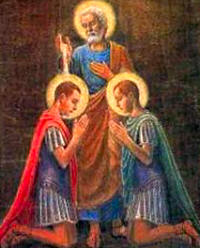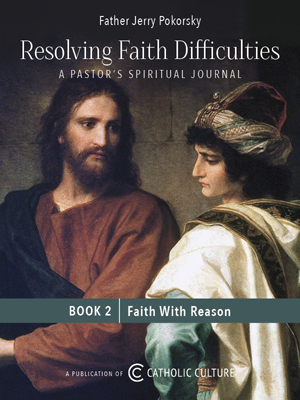Easter: May 12th
Monday of the Fourth Week of Easter; Opt. Mem. of Sts. Nereus & Achilleus, Martyrs; Opt. Mem. of St. Pancras, Martyr
Other Commemorations: Bl. Imelda Lambertini, Virgin (RM)
» Enjoy our Liturgical Seasons series of e-books!
The Church celebrates the Optional Memorial of Saints Nereus and Achilleus (d. 98) who were Roman soldiers in the household of Flavia Domitilla. They were instructed and converted by St. Peter. These two soldiers in turn inspired St. Domitilla to consecrate her virginity to God. Thereupon, Aurelianus, the fiancee of Domitilla, reported all three to the Roman authorities as being Christians. They were martyred out of hatred for Christianity.
It is also the Optional Memorial of Saint Pancras (d. 290), a noble Phrygian youth, came to Rome at the age of fourteen and was martyred in 275 because he refused to offer sacrifices to the pagan gods.
The Roman Martyrology commemorates Bl. Imelda Lambertini (1322-1333), daughter of Count Egano Lambertini of Bologna and Castora Galuzzi. She was a student at Dominican Convent of Valdi-Pietra in Bologna and had a great devotion to Saint Agnes of Rome, of whom she may have had visions. On May 12, 1333 she miraculously received her First Communion, and immediately after died in an ecstasy of love and joy.
Meditation: Monday of the Fourth Week of Easter
Jesus, the Good Shepherd
1. Easter, the day of the Lord's victory over sin and hell, the day of our resurrection to a new life (through baptism and penance), today receives a new meaning. The risen Lord is the Good Shepherd who lays down His life for His sheep. With her heart filled with gratitude, the Church recognizes Jesus as the Good Shepherd. "The earth is full of the mercy of the Lord, alleluia; by the word of the Lord [I baptize thee; I absolve thee from thy sins; this is My body, and this is My blood] were the heavens [the redeemed] made, alleluia, alleluia. Rejoice in the Lord, O ye just [the redeemed, the Church!" (Introit).
2. Jesus is the Good Shepherd. "The good shepherd giveth his life for his sheep. But the hireling and he that is not the shepherd, whose own the sheep are not, seeth the wolf coming and leaveth the sheep and flieth; and the wolf catcheth and scattereth the sheep; and the hireling flieth because he is a hireling and he hath no care for the sheep. I am the Good Shepherd; and I know Mine, and Mine know Me, as the Father knoweth Me and I know the Father; and I lay down My life for My sheep" (Gospel).
The mark by which the good shepherd is to be recognized is his selfless zeal for the welfare of the flock that has been entrusted to him. His zeal makes him willing to sacrifice his life for his flock. It is otherwise with the hireling, who works for a fee, for he is a hireling whose own the sheep are not. When he sees the enemy, the wolf, coming, he does not place himself on guard. He will not risk his own life; he assures first his own safety, for he lacks a personal interest in the flock. There is still another mark by which the true shepherd may be recognized. He knows personally each of the sheep committed to his care. For him the individual sheep is not just one among many, as would be the case with the hireling. There exists between the individual soul and Jesus a union so personal and so intimate and trusting, that the union of the Father and Son in the Blessed Trinity is mirrored in it. The mutual understanding and love of the Father and Son are reflected also by this relationship between the Good Shepherd and His flock.
Blessed are we, the baptized, the children of the Church, who have been entrusted to Jesus, the Good Shepherd. He lays down His life for His sheep. He guides each one of them, cares for them, and loves them with an intimate love, as though each sheep were His only care. What unquestioning faith and confidence we should have in the Good Shepherd!
"The Good Shepherd giveth His life for His sheep." As a matter of fact He is so concerned for our salvation that He descended from heaven, subjected Himself to suffering, and became obedient unto death for our sake. How zealously He has sought us out! He comes daily in the Mass in search of us; seeking us out, He enters our hearts each day in Holy Communion. He lives and prays for us unceasingly in the solitude of the tabernacle. He inspires us and enlightens us without ceasing, and is continually knocking at the door of our hearts with His grace. He consoles us, reproaches us, delights us, admonishes us, allows us to fall, and then raises us up; He protects us from ourselves and from our own evil inclinations, desires, and passions. "I am the Good Shepherd; and I know Mine." This assurance sustains us; for He is the Good Shepherd of my soul, and I am His chief concern. He knows me, all that is in me, both the good and the evil. His eyes follow me wherever I wander. When my way is through briars or painful thorns, He helps me; when I am in need, when I am troubled or in darkness, He comes to me. His heart beats for me, and He is always near me, even when I am obliged to go forth into a hostile world, and when I cry out in vain for love and sympathy.
3. "I am the Good Shepherd." He has risen; He, the Good Shepherd who seeks me so lovingly, lives. The man who possesses this living faith can never be poor, or homeless, or alone. There can never again be for him a sterile period, either in his heart or in his work. Let us live with the liturgy in the spirit of faith.
"I know Mine, and Mine know Me." Where? In the offering of true love. Only the spirit of sacrificial love can build a bridge between the Shepherd and His sheep. Only when love has been purified of all selfishness, can a true interior and vital union, based on perfect mutual understanding, be realized between the Shepherd and His sheep. No one can remain faithful unless he bears the imprint of the Lord's wounds in his heart. That is the mystery of the true shepherd, Jesus Christ.
—Benedict Baur, OSB, The Light of the World, Vol. 2
St. Nereus and Achilleus
The mention in the Missal of these saints awakens within us today little or no memory, but in the Christian Rome of the first centuries these names were dear to popular piety. The catacomb of Domitilla on the Ardeatine Way was well known, and the two Martyrs Nereus and Achilleus were buried there.
A certain Flavia Domitilla belongs to the illustrious family of the Flavii, which, during the first century, had given three emperors to Rome. She was the wife of the Consul Flavius Clemens, a relative of Domitian, and was one of the aristocratic Romans who had embraced Christianity. She it was who in all probability founded the catacomb referred to. Another Flavia Domitilla, grandchild of the first, was, like her, exiled for the Faith.
The two martyrs Nereus and Achilleus are also celebrated as having been in Domitian's service. Their bodies were translated from the catacomb of Domitilla to another Roman church, the basilica of Fasciola. These are ancient Roman memorials, recalling to our memory that St. Peter, delivered from prison, was preparing to leave Rome, where he feared to be put to death, the at this point on the road the little band (fasciola) tied round his leg became loosened. Stopping to retie it, Christ appeared to him. "Master, whiter goest Thou?" demanded the Apostle. "I go to Rome," replied his Lord, "there to be crucified again." Peter understood. He it was who returned to Rome, where he was to be sacrificed.
The basilica of the Fasciola, for a time abandoned, was bestowed as a title on the famous cardinal Baronius, towards the close of the sixteenth century. The Cardinal restored it, and it may be visited today. It was known by the names of SS. Nereus and Achilleus even before their translation.
The Acts of these Martyrs do not belong to the class of Acta sincera; fantastic details have been added, embroidered upon authentic facts which are guaranteed by these tombs and these churches. On of St. Gregory's Homilies was pronounced over their tomb, and a Damasian inscription is dedicated to them.
Archeologists have studied these Acts profoundly during the last few years. The latest hypothesis, which appears more or less justified, would place their martyrdom in the reign of Nero, in the year 63. In this case these two soldiers, of Germanic origin, would be the proto-martyrs of the Roman Church.
—Excerpted from The Year's Liturgy, Volume 2 by Fernand Cabrol, OSB
Symbols and Representation: Two posts and lions; fire; two swords.
Highlights and Things to Do:
- Even though Nereus and Achilleus died for Christ about 1800 years ago, Christians are still suffering and dying for their faith in this century. Offer a prayer for the persecuted Church and for the modern martyrs.
- These two Roman soldiers threw away their "shields, their armor, and their blood-stained javelins" and gave their lives for Christ. Examine how much you are willing to sacrifice for the love of Christ and offer up a small sacrifice today.
- Read more about Nereus and Achilleus:
- See the statues on the St. Peter's Colonnade: Nereus and Achilleus.
- Their remains are located in Santi Nereo e Achilleo (Church of Saints Nereus and Achilleus) in Rome.
St. Pancras
 Pancratius was the descendant of a noble Phrygian family. As a youth of fourteen, he came to Rome while Diocletian and Maximian were in power (about 304). He was baptized by the Pope and given instructions in the Christian religion. Arrested for his action, he steadfastly refused to sacrifice to the pagan gods and was condemned to death. With manly courage, he bared his neck for the sword and received the martyr's crown. During the night his body was removed by the pious matron Octavilla, anointed with sweet smelling balsam and interred on the Via Aurelia.
Pancratius was the descendant of a noble Phrygian family. As a youth of fourteen, he came to Rome while Diocletian and Maximian were in power (about 304). He was baptized by the Pope and given instructions in the Christian religion. Arrested for his action, he steadfastly refused to sacrifice to the pagan gods and was condemned to death. With manly courage, he bared his neck for the sword and received the martyr's crown. During the night his body was removed by the pious matron Octavilla, anointed with sweet smelling balsam and interred on the Via Aurelia.
Pancratius is the patron saint of fidelity to oaths. The basilica that Pope Symmachus erected over his remains about the year 500 later became a station church (since 1798 his relics have been lost). On the first Sunday after Easter the saint exhorted the catechumens gathered at his station church to remain loyal to their baptismal vows. The saint warns us to proceed slowly and prudently before taking an oath or vow. But once our word is given we must remain true to our pledge, true unto death itself, whether it concerns baptismal vows, ordination vows, profession vows, or marriage vows.
—Excerpted from The Church's Year of Grace, Pius Parsch.
Symbols and Representation: Sword and stone; armor; Saracen crown under his feet.
Patronage: Against false witness; against perjury; children; cramps; headaches; fidelity to oaths; treaties.
Highlights and Things to Do:
- Read more about St. Pancras:
- See St. Pancras' statue on the St. Peter's Basilica Colonnade.
- The Church of San Pancrazio was built over the tomb of St. Pancras. Saints in Rome gives more expansion on the location of Pancras' relics.
Bl. Imelda Lambertini
 Bl. Imelda Lambertini is a model for all in her great love for the Blessed Sacrament. Born in Bologna, she was a pious child who begged her parents to allow her to become a Dominican when she was just nine. Her parents, though saddened at having to be separated from their only child, recognized God's will for their daughter, and Imelda joined the nuns at Val di Pietra.
Bl. Imelda Lambertini is a model for all in her great love for the Blessed Sacrament. Born in Bologna, she was a pious child who begged her parents to allow her to become a Dominican when she was just nine. Her parents, though saddened at having to be separated from their only child, recognized God's will for their daughter, and Imelda joined the nuns at Val di Pietra.
Her status among the nuns is unclear. She received the habit and participated in the life of the nuns to some extent.
At that time, children were not allowed to make their First Holy Communion until age 14, but Imelda prayed continually that she would be able to receive Our Lord without having to wait so long. When she was 11, after Mass on the vigil of the Feast of the Ascension, the Sacred Host was seen suspended amidst a brilliant light above Imelda's head. The chaplain, who was immediately summoned, gave the Host to Imelda. Afterwords, the nuns left her alone to make her thanksgiving. The prioress soon discovered, however, that Imelda, who had been in ecstasy, had died shortly after receiving her First Holy Communion, so much in love was she with Our Lord in the Eucharist.
Blessed Imelda was declared Patroness of First Communicants by Pope St. Pius X.
Symbols and Representation: very young Dominican novice kneeling before the altar with a sacred Host appearing above her; wearing first communion dress, chapel veil with attached to a chaplet of flowers on her head and rosary
Patronage: First Communicants
Highlights and Things to Do:
- Read more about Bl. Imelda:
- Catholic Cuisine has an inspirational post on "Kids in the Kitchen," inspired by young Blessed Imelda.
- Bl. Imelda's body remains incorrupt, and it is located in the San Sigismondo Church in Bologna, Italy.






